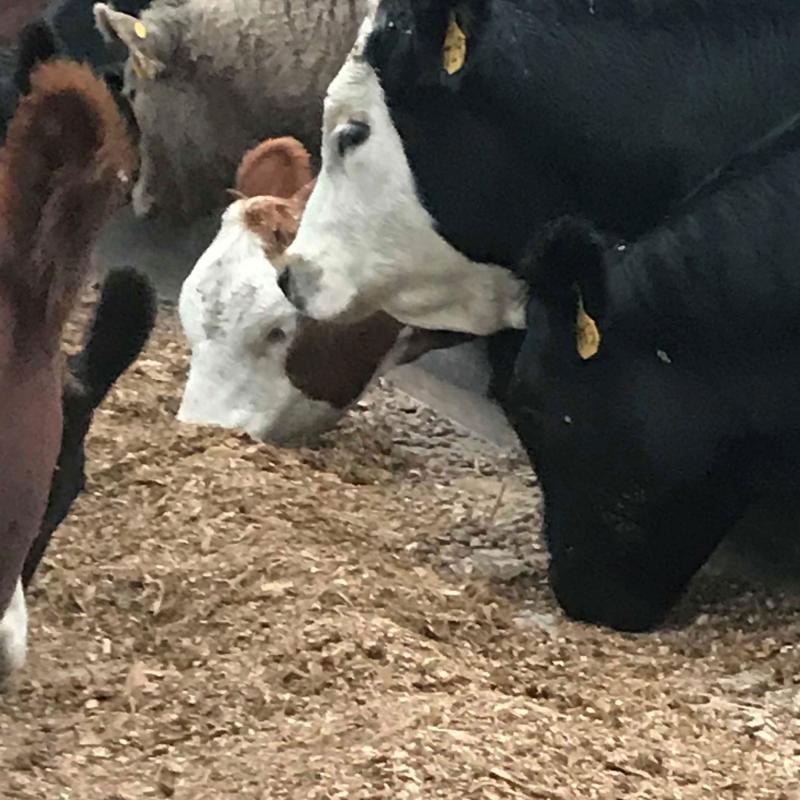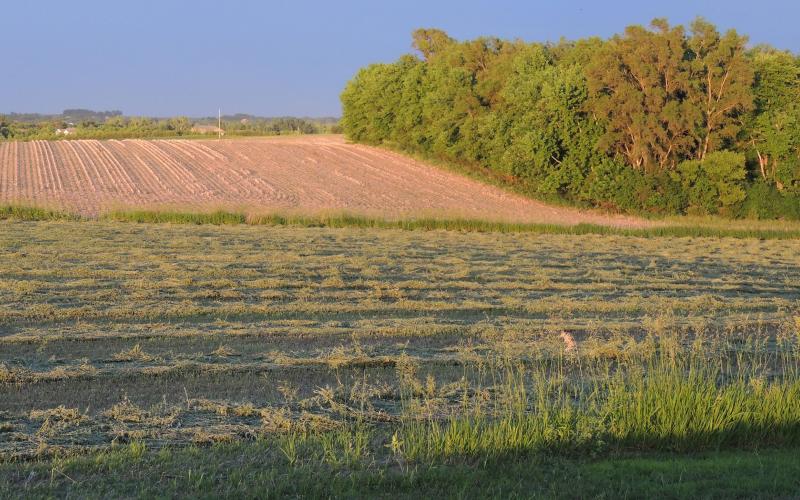
Written collaboratively by Tracey Erickson, former SDSU Extension Dairy Field Specialist and Sara Bauder, SDSU Extension Agronomy Field Specialist.
Fall is on its way in South Dakota. However, with many flooded and saturated fields, some producers are growing concerned that there will be little opportunity to harvest silage before corn dries down past desired moisture levels or frost occurs.
Creating quality silage is most dependent on harvest plant moisture. Ideally, when chopping silage, the plant should be 32-38% dry matter (Akins, 2018). Moisture calculation is key, and given the genetics of today’s corn varieties, the relationship between milk line and plant moisture content may not always be accurate. Harvesting at over 40% dry matter reduces digestibility of fiber and starch, and may cause packing issues. More specifically, the optimum silage moisture ranges from 55-60% for upright oxygen-limiting solos, 60-65% for upright stave silos, 60-70% for bags, and 65-70% for bunkers (Bernhart, 2018). In other words, wetter silage tends to work better in bags, bunkers, and piles for better packing; dryer silage tends to work better in upright silos to minimize seepage.
Calculating Dry Matter
An easy, quick, and relatively inexpensive method to determine the actual moisture content of the whole corn plant is using a microwave oven. This typically takes less than 20 minutes to test.
Equipment Needed
- Microwave, with a turntable (preferably). Do NOT use the kitchen microwave, as it does produce an unpleasant odor; your family will thank you.
- Scale; one that weighs in grams is best.
- Container; something that is microwave safe such as paper plate, paper boat, or a glass or plastic dish.
- Water; an 8 oz glass to protect the microwave oven.
- Paper & Pencil to record weights.
- Calculator.
Sample Collection
Collect at random 10-20 plants throughout the field. You will need to chop these plants by either shredding them in a brush chopper/branch shredder or by running them through your silage chopper. Please keep in mind that this can be a very dangerous process and care should be taken when shredding. The other option is to chop test areas in your field. Then, take random grab samples from the green chopped silage. You should have about 2 gallons worth of product to mix and collect your test sample from.
Microwave Moisture Testing for Forages
- Using your gram scale, weigh the container you will use to hold the sample. This weight is known as Value A.
- Mix your sample and place about 100 grams in the container. Collect the total weight of the container and wet sample, record the weight as Value B.
- Put an 8oz. glass of water in the corner of the oven.
- Put the container with the sample in the microwave oven. Using a medium to high heat setting, start drying the sample. Start with approximately 3-4 minutes if you suspect the sample is above 35% moisture.
- After microwaving, remove the container and sample, weigh them, and record the weight. It should weigh less than the Value B that you initially recorded.
- Gently stir the sample and place back in the microwave.
- Reheat the sample again for another 30 seconds. Remove, re-weigh, and record the weight. You should continue this process, recording the weight every time.
- Be careful not to char or burn the sample. If this occurs, either start over or take the previous recorded weight prior to charring the sample.
- Once you have two continuous weights that are equal, the sample is considered dry. Record this final weight as Value C.
- Lastly you will need to calculate the percent moisture using the following formula: (B - C) ÷ (B - A) × 100 = % Moisture
- Value A = weight of container
- Value B = weight of container + initial wet sample weight
- Value C = weight of container + dry sample weight
What Now?
With many acres of corn planted later than average this year, there are still options for farmers who want to produce wet feed. Equipment availability and plant moisture should help determine what works best on your operation. If precipitation continues, famers may have to wait until freeze-up to enter some fields.
Chopping Dry Silage
Although not ideal for optimum feed value and storage, if a producer chooses to chop silage above 40% dry matter, there are several considerations to make:
- Reduce chop length to release more plant fluids and improve packing.
- Use a kernel processor to improve digestibility- the more mature the corn the less digestible it becomes.
- Use silage inoculants to improve fermentation. Liquid inoculants may be more effective in dry silage.
- If piling or using bunker silos, use extra heavy tractors for packing and pack no more than 6 inches at a time.
- Blend wetter feeds with your dry silage like forage sorghum, alfalfa, later-planted green corn.
- Place your wettest forage on the top layer of the pile or horizontal bunker for sealing and weight. Adding water to the top layer of the pile may also help with this.
- Cover tightly with silage plastic and/or oxygen barrier to keep the environment as anaerobic as possible.
Some producers may choose to add water as they pile or fill silos; however, it takes approximately 7 gallons of water for every ton of silage to raise moisture content 1 point and corn plant material absorbs water quite slowly. Therefore, a large amount of water would be required at a very fast rate to keep up with most silage harvest processes, making wetting nearly impossible to render major results.
Chopping Earlage
Earlage is defined as ensiled corn grain, cobs, and in some cases, husks and a portion of the stalk depending upon harvest method (Lardy, 2016). With an energy content higher than corn silage but lower than corn grain and a similar protein content to corn silage, earlage makes a good alternative. Ideally moisture content is 35 to 40% (60-65% dry matter). A silage chopper with a snapper head can be used. Other producers have successfully used combines set to retain a portion of the cob with the grain. Much like silage, if harvested too wet, seepage may occur; if harvested too dry it will not pack well which will cause excessive spoilage. Things to consider when chopping earlage:
- Make sure that every kernel is cracked and that the cob portions are no larger than a thumbnail to improve pack density and digestibility.
- Consider using a kernel processor to improve digestibility.
- Use inoculants to improve fermentation.
- If piling or using bunker silos, use extra heavy tractors for packing.
- Cover tightly with silage plastic and/or an oxygen barrier to keep the environment as anaerobic as possible.
What to Watch For

Moisture is critical when harvesting silage. Remember that if the silage is too wet there is a risk of butyric acid forming and nutrients being lost due to seepage. Silage that is over 70% moisture should not be harvested and should stand in the field for a few more days. On the other hand, if it is too dry it will not ferment or pack adequately resulting in mold development. Therefore, having an accurate determination of your corn silage moisture is critical in putting up good silage in a timely manner.
In addition, flooded corn can contain many contaminants. Watch for corn ear molds, stalk molds, and if the plant is quite dirty, soil contaminants. Preservatives and fermentation do not lower the concentration of these toxins in your feed. If you have concerns or have seen any of these issues in the field, first consider identifying ear or stalk diseases. Before feeding any feedstuffs you should take proper feed samples and have a quality analysis conducted, so that an accurate ration can be developed that will ensure maximum performance for your livestock ration. Contacting your crop insurance agent before harvest is recommended to determine that the right insurance protocols are followed, in case you desire to file a crop insurance claim. For more information about silage contaminants and mycotoxins, view the article “Mycotoxin Considerations for Weather-Damaged Feedstuffs.”
Pricing or Buying Feed
If it becomes necessary, use the Silage Earlage Decision Aid for help pricing silage or earlage in South Dakota. Alternatively, use the "Feed & Forage Finder" Facebook page for help finding feed for sale in your area.
This has been a challenging year with heavy spring precipitation and now extensive fall precipitation in some parts of Southeastern South Dakota. Remember, all hope is not lost for your silage crop- keep the options above in mind and have a safe harvest this year.
Resources and References:
- B. Anderson, 2015. Making Silage out of Dry Corn.
- M. Akins, 2018. Corn Silage Harvest Management.
- S. Bernhart, 2009. Harvesting High-Quality Corn Silage.
- T. Erickson. 2019. Mycotoxin Considerations for Weather-Damaged Feedstuffs.
- G. Lardy, 2016. Harvesting, Storing and Feeding Corn as Earlage.
- D. Schwab, 2018. Silage Making with 2018 Weather Challenges.

